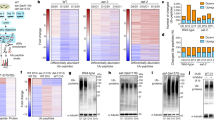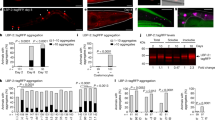Abstract
CADMIUM is a potent poison for living cells. In man, chronic exposure to low levels of cadmium results in damage to kidneys and has been linked to neoplastic disease and ageing, and acute exposure can cause damage to a variety of organs and tissues1. Cadmium reacts with thiol groups and can substitute for zinc in certain proteins2, but the reason for its toxicity in vivo remains uncertain. In eukaryotes, an important selective proteolysis pathway for the elimination of abnormal proteins that are generated under normal or stress conditions is ATP-dependent and mediated by the ubiquitin system3–5. Substrates of this pathway are first recognized by ubiquitin-conjugating enzymes5–7 (or auxiliary factors) which covalently attach ubiquitin, a small and highly conserved protein, to specific internal lysine residues of proteolytic substrates. Ubiquitinated substrates are then degraded by the proteasome, a multisubunit protease complex8–10. Here we show that expression of this ubiquitin-dependent proteolysis pathway in yeast is activated in response to cadmium exposure and that mutants deficient in specific ubiquitin-conjugating enzymes are hypersensitive to cadmium. Moreover, mutants in the proteasome are hypersensitive to cadmium, suggesting that cadmium resistance is mediated in part by degradation of abnormal proteins. This indicates that a major reason for cadmium toxicity may be cadmium-induced formation of abnormal proteins.
This is a preview of subscription content, access via your institution
Access options
Subscribe to this journal
Receive 51 print issues and online access
$199.00 per year
only $3.90 per issue
Buy this article
- Purchase on Springer Link
- Instant access to full article PDF
Prices may be subject to local taxes which are calculated during checkout
Similar content being viewed by others
References
Stoeppler, M. & Piscator, M. (eds) Cadmium (Springer, Berlin, 1985).
Vallee, B. L. & Ulmer, D. A. Rev. Biochem. 41, 91–129 (1972).
Finley, D. & Chau, V. A. Rev. Cell Biol. 7, 25–69 (1986).
Hershko, A. Trends biochem. Sci. 16, 265–268 (1991).
Jentsch, S. Trends Cell Biol. 2, 98–103 (1992).
Jentsch, S., Seufert, W., Sommer, T. & Reins, H.-A. Trends biochem. Sci. 15, 195–198 (1990).
Jentsch, S. A. Rev. Genet. 26, 177–205 (1992).
Hough, R., Pratt, G. & Rechsteiner, M. J. biol. Chem. 261, 2400–2408 (1986).
Waxman, L., Fagan, J. M. & Goldberg, A. L. J. biol. Chem. 262, 2451–2457 (1987).
Seufert, W. & Jentsch, S. EMBO J. 11, 3077–3080 (1992).
Seufert, W., McGrath, J. P. & Jentsch, S. EMBO J. 9, 4535–4541 (1990).
Seufert, W. & Jentsch, S. EMBO J. 9, 543–550 (1990).
Jentsch, S., McGrath, J. P. & Varshavsky, A. Nature 329, 131–134 (1987).
Heinemeyer, W., Kleinschmidt, J. A., Saidowsky, J., Escher, C. & Wolf, D. H. EMBO J. 10, 555–562 (1991).
Finley, D., özkaynak, E. & Varshavsky, A. Cell 48, 1035–1046 (1987).
Hamer, D. H. A. Rev. Biochem. 55, 913–951 (1986).
Grill, E., Winnacker, E.-L. & Zenk, M. H. Science 230, 674–676 (1985).
Ortiz, D. F. et al. EMBO J. 11, 3491–3499 (1992).
Sanchez, Y., Taulien, J., Borkovich, K. A. & Lindquist, S. EMBO J. 11, 2357–2364 (1992).
Van Nocker, S. & Vierstra, R. D. Proc. natn. Acad. Sci. U.S.A. 88, 10297–10301 (1991).
Phelps, A., Schobert, C. T. & Wohlrab, H. Biochemistry 30, 248–252 (1991).
Broach, J. R., Strathern, J. N. & Hicks, J. B. Gene 8, 121–133 (1979).
Sherman, F., Fink, G. R. & Hicks, J. B. Methods in Yeast Genetics (Cold Spring Harbor Laboratory Press, New York, 1986).
Ausubel, F. M. et al. (eds) Current Protocols in Molecular Biology (Green and Wiley, New York, 1991).
Author information
Authors and Affiliations
Rights and permissions
About this article
Cite this article
Jungmann, J., Reins, HA., Schobert, C. et al. Resistance to cadmium mediated by ubiquitin-dependent proteolysis. Nature 361, 369–371 (1993). https://doi.org/10.1038/361369a0
Received:
Accepted:
Issue Date:
DOI: https://doi.org/10.1038/361369a0
This article is cited by
-
Pieces of evidence of enhanced cellulose biosynthesis in the low-Cd cultivar and high expression level of transportation genes in the high-Cd cultivar of Lactuca sativa
Environmental Science and Pollution Research (2022)
-
Activation of multiple proteolysis systems contributes to acute cadmium cytotoxicity
Molecular and Cellular Biochemistry (2022)
-
Molecular Biology of Cadmium Toxicity in Saccharomyces cerevisiae
Biological Trace Element Research (2021)
-
Loss of ERAD bridging factor UBX2 modulates lipid metabolism and leads to ER stress-associated apoptosis during cadmium toxicity in Saccharomyces cerevisiae
Current Genetics (2020)
-
Cadmium effects on DNA and protein metabolism in oyster (Crassostrea gigas) revealed by proteomic analyses
Scientific Reports (2017)
Comments
By submitting a comment you agree to abide by our Terms and Community Guidelines. If you find something abusive or that does not comply with our terms or guidelines please flag it as inappropriate.



